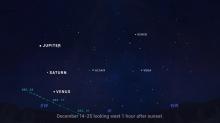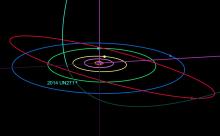Listen to today's episode of StarDate on the web the same day it airs in high-quality streaming audio without any extra ads or announcements. Choose a $8 one-month pass, or listen every day for a year for just $30.
You are here
The ‘Angry Star’
A brilliant comet streaked across the sky four centuries ago. It brought consternation to many — but a poetic plea to not worry about it from the king of England.
Neither the king nor anyone else saw the comet coming. It skirted the Sun on November 8th, 1618, passing about as close to the Sun as the planet Mercury does. But it wasn’t spotted for another eight days, when observers saw its tail in the pre-dawn sky. Eventually, the tail stretched all the way from Libra, in the southern sky, to the Big Dipper, in the far-northern sky.
The red-hued comet passed by Earth in early December. It grew so bright that it was visible even during the day. Because of its color, the length of its tail, and its long run in the sky, it was called “the Angry Star.”
Today, we know that comets are blobs of frozen water and gases mixed with rock and dirt. As the Great Comet of 1618 approached the Sun, some of its ice vaporized, producing the glorious tail.
400 years ago, though, no one knew how comets worked. At the time, many thought of them as omens of evil. But King James I penned a poem to reassure his people. Part of it went like this:
“Misinterpret not with vain conceit, / The character you see of Heaven’s height: / Which, though it bring the World some news from fate, / The letter is such as none can it translate.”
In other words, we don’t really know what it means, so don’t worry about it — just enjoy the show.
Script by Ken Croswell and Damond Benningfield





